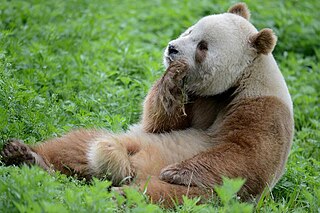Related Research Articles

The giant panda, also known as the panda bear or simply panda, is a bear species endemic to China. It is characterised by its white coat with black patches around the eyes, ears, legs and shoulders. Its body is rotund; adult individuals weigh 100 to 115 kg and are typically 1.2 to 1.9 m long. It is sexually dimorphic, with males being typically 10 to 20% larger than females. A thumb is visible on its forepaw, which helps in holding bamboo in place for feeding. It has large molar teeth and expanded temporal fossa to meet its dietary requirements. It can digest starch and is mostly herbivorous with a diet consisting almost entirely of bamboo and bamboo shoots.

The red panda, also known as the lesser panda, is a small mammal native to the eastern Himalayas and southwestern China. It has dense reddish-brown fur with a black belly and legs, white-lined ears, a mostly white muzzle and a ringed tail. Its head-to-body length is 51–63.5 cm (20.1–25.0 in) with a 28–48.5 cm (11.0–19.1 in) tail, and it weighs between 3.2 and 15 kg. It is well adapted to climbing due to its flexible joints and curved semi-retractile claws.

The Toronto Zoo is a zoo located in Toronto, Ontario, Canada. Encompassing 287 hectares, the Toronto Zoo is the largest zoo in Canada averaging around 1.2 million visitors a year. The zoo is divided into seven zoogeographic regions: Indo-Malaya, Africa, Americas, Tundra Trek, Australasia, Eurasia, and the Canadian Domain. Some animals are displayed indoors in pavilions and outdoors in what would be their naturalistic environments, with viewing at many levels. The zoo also has areas such as the Kids Zoo, Waterside Theatre, and Splash Island. The zoo has one of the most taxonomically diverse collection of animals on display of any zoo worldwide and is currently home to over 3,000 animals representing over 300 species. The zoo is open to the public every day of the year.

The Wilder Institute/Calgary Zoo is located in Bridgeland, Calgary, Alberta, Canada, just east of the city's downtown and adjacent to the Inglewood and East Village neighborhoods. It is accessible via Calgary's C-Train light rail system, by car via Memorial Drive, and by bicycle and footpath via the Bow River pathway. A large portion of the zoo is located on St. George's Island in the Bow River.

An ursid hybrid is an animal with parents from two different species or subspecies of the bear family (Ursidae). Species and subspecies of bear known to have produced offspring with another bear species or subspecies include American black bears, grizzly bears, and polar bears, all of which are members of the genus Ursus. Bears not included in Ursus, such as the giant panda, are expected to be unable to produce hybrids with other bears. The giant panda bear belongs to the genus Ailuropoda.
Panda diplomacy is the practice of sending giant pandas from China to other countries as a tool of diplomacy and wildlife conservation. From 1941 to 1984, the Chinese government gifted pandas to other countries. Since 1984, they have been leased rather than gifted due to a PRC policy change.

The Qinling panda, also known as the brown panda, is a subspecies of the giant panda, discovered in 1959, but not recognized as a subspecies until 2005. Besides the nominate subspecies, it is the first giant panda subspecies to be recognized.

Hua Mei is a female giant panda. She is the first giant panda cub to survive to adulthood in the United States. She was born to Bai Yun (mother) and Shi Shi (father) at the San Diego Zoo. Millions of people around the world watched Hua Mei grow up via the zoo's Panda Cam.

Wolong National Nature Reserve, officially known as Wolong Special Administrative Region, is a national protected area located in Wenchuan County in China.

Mei Xiang is a female giant panda who lived at the National Zoo in Washington D.C.

Tian Tian is a 275-pound male giant panda formerly at the National Zoo in Washington D.C. The panda was born on August 27, 1997, at the China Conservation and Research Center for the Giant Panda at the Wolong National Nature Reserve in Sichuan Province, to Yong Ba (mother) and Pan Pan (father). Tian Tian is the half-brother of Bai Yun, formerly at the San Diego Zoo.

Lun Lun is a female giant panda at Zoo Atlanta in Atlanta, Georgia. The panda, now 242 pounds (110 kg), was born at the Chengdu Research Base of Giant Panda Breeding in China on August 25, 1997. Her original name, Hua Hua, was changed to Lun Lun by her sponsor, the Taiwanese rock star Su Huilun.

Chi Chi was a well-known female giant panda at London Zoo in England.

Chuang Chuang and Lin Hui were two giant pandas from Sichuan, China on loan to Chiang Mai Zoo in Chiang Mai, Thailand.

Bao Bao is a female giant panda cub who was born at the National Zoo in Washington, D.C. She lived at the Zoo for four years until February 2017. She is currently located at the China Conservation and Research Center for the Giant Panda in Sichuan Province. She is the sister of Tai Shan, Bei Bei and Xiao Qi Ji.

Chongqing Zoo is a zoo in the city of Chongqing, China, about 8 km southwest from the city centre.
As of 2019, there are 26 zoos in 21 countries and area(s) outside of mainland China, that have giant pandas. These zoos have contracts with China to house these pandas for a few years. The two exceptions are the three pandas held at Taipei Zoo, which are given from the Chinese Mainland, and one panda held in Mexico. Giant pandas are on the IUCN Red List so part of the reason these contracts exist between China and international zoos is to try to help the species reproduce before they are brought back to their native land. For this reason, pandas are treated very well.
Da Mao is a giant panda that was born at the Chengdu Research Base of Giant Panda Breeding. He was born to Mao Mao (female) and Yuhin/Xiongbang (male). The name Da Mao means "first of Mao" as he was his mother's first born.
Jia Yueyue and Jia Panpan are twin giant pandas born at the Toronto Zoo on 13 October 2015, to mother, Er Shun and father, Da Mao. They were the first giant pandas to be born in Canada, and only the second giant panda twins to survive the neonatal period in North America. Their birth was the result of one of two artificial insemination procedures overnight from 13 to 14 May 2015. The pandas went on public exhibit at the zoo on 12 March 2016. The last day that the giant pandas were viewable at the Toronto Zoo was 18 March 2018. The two pandas have since left Canada and now reside at the Chengdu Research Base of Giant Panda Breeding.
References
- ↑ "大熊猫"二顺"多伦多生崽"好事多磨"" . Retrieved 2015-10-15.
- ↑ "Toronto Zoo's mystery of the mistaken male panda". Toronto Star . 6 December 2012.
- ↑ "Toronto Zoo | Press Releases".
- ↑ "Toronto Zoo | Press Releases".
- ↑ Magnus, Gabriel; Dutton, Christopher; Mastromonaco, Gabriela; Gartley, Cathy; MacDonald, Suzanne; Franke, Maria (2022). "Luteal phase length, endometrial edema, and behavior differentiate post-ovulatory events in a giant panda (Ailuropoda melanoleuca)". Zoo Biology. 41 (2): 130–142. doi:10.1002/zoo.21655. PMID 34672395. S2CID 239051542.
- ↑ "Toronto Zoo announces birth of twin giant pandas | CBC News".
- ↑ Magnus, G.; Dutton, C.; Mastromonaco, G.; Gartley, C.; MacDonald, S.; Franke, M. (2022). "Luteal phase length, endometrial edema, and behavior differentiate post-ovulatory events in a giant panda (Ailuropoda melanoleuca) | Zoo Biology". Zoo Biology. 41 (2): 130–142. doi:10.1002/zoo.21655. PMID 34672395. S2CID 239051542.
- ↑ "Toronto Zoo | Press Releases".
- ↑ "Calgary Zoo to ship giant pandas back to China early due to bamboo supply problems". CBC. May 12, 2020. Retrieved May 13, 2020.
- ↑ "Zoo to return pandas to China because bamboo too hard to get". NBC News. 15 May 2020. Retrieved 2022-01-08.